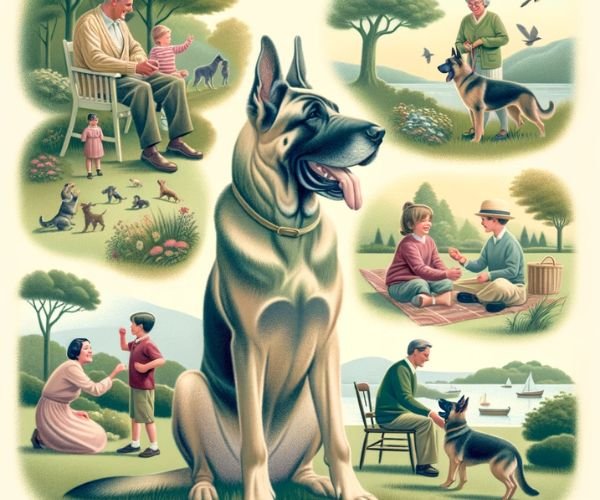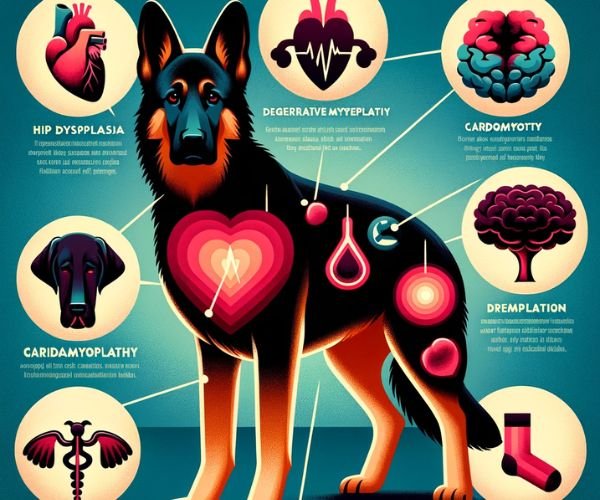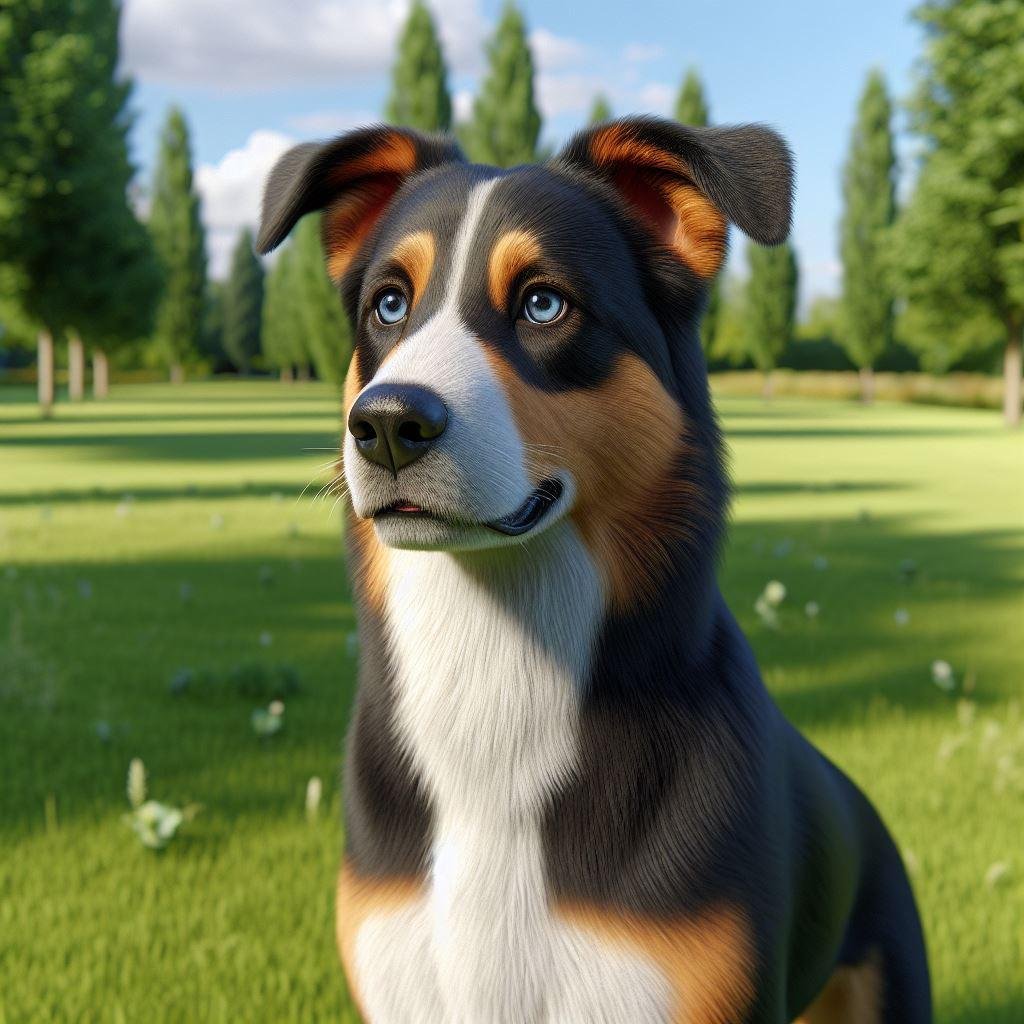The German Shepherd and Great Dane mix, often called a “Great Shepherd,” is a unique and impressive crossbreed. This hybrid combines the intelligence and loyalty of the German Shepherd with the size and gentle nature of the Great Dane.
Typically, a Great Shepherd inherits both parent breeds’ robust and muscular build, often leaning towards the larger size due to the Great Dane’s influence. Their coat can vary, reflecting either the Great Dane’s short hair or the German Shepherd’s denser coat, and comes in various colors and patterns.
These dogs are known for their protective yet friendly demeanor. They usually make excellent family pets and are good with children, thanks to their patient and affectionate nature. However, their size and strength make early training and socialization crucial to ensuring they are well-behaved and manageable. They are also quite active and require regular exercise to keep them healthy and happy.
The Great Shepherd can be prone to some health issues common to its parent breeds, such as hip dysplasia and bloat. Regular veterinary check-ups and a healthy diet are essential for maintaining their well-being. The German Shepherd and Great Dane mix is a remarkable and loyal companion, suitable for families looking for a large, active, and loving dog.
German Shepherd and Great Dane mix dogs.
The German Shepherd and Great Dane mix, commonly known as the Great Shepherd, is a hybrid dog breed that combines the best traits of its parent breeds: the intelligence and loyalty of the German Shepherd and the size and gentleness of the Great Dane. This mix results in a large, powerful dog with a commanding presence and a heart full of affection.

Dogs like these require regular exercise to stay healthy and happy. Energy-exhausting households suit them best. In terms of health, they may inherit some common issues from their parent breeds, like hip dysplasia and bloat, so regular veterinary care and a proper diet are vital.
The German Shepherd and Great Dane mix is ideal for families seeking a large, intelligent, loyal pet. Their impressive size and friendly demeanor make them popular for those wanting a protective yet loving companion. A Great Shepherd can be an excellent addition to any home with the proper care and training.
Parent Background
Please look at the distinctive qualities of combining two breeds to create a German Shepherd/Great Dane mix, making it a truly unique and remarkable breed.
The German Shepherd
The German Shepherd, known for its intelligence, loyalty, and versatility, has a fascinating parent background deeply rooted in Germany. This breed’s history dates back to the late 19th century, when Captain Max von Stephanitz, a German cavalry officer, embarked on a mission to develop the ideal herding and working dog. His vision was to create a breed with the perfect combination of intelligence, strength, and trainability for various tasks.
Captain von Stephanitz achieved this goal by selectively breeding working dogs with the desired traits. He started with local herding dogs from Germany, primarily the Thuringian, Württemberg, Bavarian sheepdogs, and other regional breeds. These dogs formed the foundation for developing the German Shepherd we know today.
The Great
The Great Dane, often known as the “gentle giant,” possesses a diverse and intriguing parent background that has shaped its unique traits. Contrary to its name, this breed’s origins are not exclusively Danish but can be traced back to ancient Greece and Egypt, where they were utilized as hunting and guard dogs.
The breed’s development and refinement occurred in Europe during the Middle Ages, with European nobility playing a pivotal role in its evolution. The infusion of mastiff bloodlines and selective breeding practices contributed to the Great Dane’s impressive stature, gentle temperament, and distinctive appearance. This breed’s rich and complex parent background highlights its enduring appeal as a remarkable and beloved canine companion.
Why is it a good mix?
The German Shepherd and Great Dane mix is a unique canine hybrid that combines two distinct breeds, each with its characteristics and qualities. This mix offers a combination of traits that can make it an excellent choice for the right owner.
However, it’s important to note that this mix can also be significant and energetic, requiring ample space, exercise, and proper training to ensure a well-adjusted and happy pet. Overall, the German Shepherd and Great Dane mix can be an excellent choice for those who appreciate the qualities of both breeds and are prepared to provide the care and attention such a unique hybrid deserves.
Physical Appearance of the Great Dane German Shepherd Mix
The physical appearance of the Great Dane German Shepherd Mix is a combination that can result in a truly striking and impressive dog. This hybrid typically inherits characteristics from both parent breeds, creating a unique and eye-catching appearance. Here’s a brief overview in tabular form:
Table
| Feature | Description |
| Size | were almond-shaped, with colors ranging from dark brown to lighter hues, expressing a keen and alert demeanor. |
| Weight | They can weigh between 65 and 130 pounds, with some males exceeding this range due to the Great Dane’s large size. |
| Body Shape | Muscular and athletic, reflecting a blend of both breeds’ physical prowess. They possess a sturdy frame, a broad chest, and strong legs. |
| Coat Type | Common colors include black, brown, tan, cream, and the German Shepherd’s distinctive black and tan markings. |
| Coat Color | were almond-shaped, with colors ranging from dark brown to lighter hues, expressing a keen and alert demeanour. |
| Head Shape | The head may resemble either breed but often has a long, narrow shape with a pronounced muzzle, reflecting their mixed heritage. |
| Eyes | were almond-shaped, with colors ranging from dark brown to lighter hues, expressing a keen and alert demeanor. |
| Ears | can be medium-sized, erected like a German Shepherd, or folded like a Great Dane. |
| Tail | Long and tapering, capable of wagging energetically or hanging down when the dog rests. |
| Lifespan | Typically, they have a lifespan of 8 to 12 years, depending on health and genetic factors. |
| Temperament | is known for being affectionate, loyal, and protective. They can be excellent family pets with proper training and socialization. |
Typical Temperament

Trainability
The German Shepherd and Great Dane Mix is known for its high level of trainability, which it often inherits from its German Shepherd parent. These dogs are intelligent and eager to please, making them quick learners regarding obedience training and commands.
Socialization
Proper socialization is crucial for the German Shepherd and Great Dane mix to ensure they become well-adjusted and confident pets. Early socialization is essential to expose them to various people, animals, and environments.
Acting around children
When adequately socialized and trained, the German Shepherd and Great Dane Mix can be excellent family pets, including households with children. They are often protective of their family members, including kids, and their gentle nature, mainly inherited from the Great Dane side, makes them generally good around children.
However, supervision and teaching children to interact respectfully with the dog are crucial to ensuring a harmonious relationship. Early exposure to children during socialization can help develop positive associations and behaviors around them.
The Watchdog Vs. Family Dog Dilemma
Owning a German Shepherd and Great Dane Mix often presents a unique dilemma for potential owners: balancing their innate watchdog instincts with their roles as family dogs. These dogs are known for their protective natures, inherited from both parent breeds.
German Shepherds have a strong guarding instinct and are often used as police and protection dogs, while Great Danes have a gentle giant reputation but are also protective of their loved ones. When these two breeds are mixed, it can result in a canine companion with protective qualities and a loving disposition.
Potential Health Issues of This Dog Mix

When considering the health of mixed-breed dogs, they must be aware of the potential health issues they may inherit from their parent breeds. This discussion will focus on a specific mix and address common health concerns such as obesity, hip dysplasia, allergies, heart problems, cancer, and stomach torsion. Understanding these issues can help owners provide the best care for their furry companions.
Bloat
Bloat, or gastric dilatation-volvulus (GDV), is a life-threatening condition where the stomach fills with gas and twists. It’s more common in large, deep-chested breeds and can be fatal if not treated immediately. Symptoms include a swollen abdomen, excessive drooling, and distress.
Hip Dysplasia
Hip dysplasia is a hereditary condition where the hip joint doesn’t fit correctly, leading to arthritis and lameness. It’s prevalent in larger breeds, but it can affect any dog. A healthy weight, regular exercise, and veterinary screenings can help manage this condition.
Allergies
Dogs, like humans, can suffer from allergies. These can be environmental, food-related, or due to fleas. Symptoms include itching, red skin, and gastrointestinal issues. Management of this condition requires identifying allergens and avoiding them.
Heart problems
Various heart diseases, including congenital disabilities, valve diseases, and heartworm disease, can affect dogs. Symptoms might include coughing, fatigue, and breathing difficulties. Regular check-ups and a healthy lifestyle are vital for prevention and early detection.
Cancer
Cancer can affect dogs of any breed and age. The risk increases with age, and certain breeds are more predisposed to specific types of cancer. Early detection through regular veterinary visits is critical to successful treatment.
Stomach
Similar to bloating, stomach torsion involves the stomach twisting on itself, which can cut off blood flow. It requires immediate veterinary attention. Preventive measures include feeding smaller, more frequent meals and avoiding vigorous exercise after eating.
Lifespan
The lifespan of a German Shepherd and Great Dane mix, often referred to as a “Great Shepherd,” typically ranges from 8 to 13 years. This lifespan is motivated by the genetic developments it inherits from its determined breeds. German Shepherds usually live about 9–13 years, while Great Danes have a shorter lifespan, often 7–10 years.
Little-Known Facts about the Dane Shepherd
The German Shepherd and Great Dane mix, known as the Dane Shepherd, is a unique hybrid that combines the distinct characteristics of its parent breeds. These dogs are giant, inheriting the Great Dane’s impressive size, often leaving a lasting impression due to their towering stature and commanding presence.

However, despite their size, they inherit a certain wariness of strangers from the German Shepherd side, making them cautious and alert around unfamiliar people. While making them excellent watchdogs, this trait also means they require proper socialization from a young age.
Additionally, drawing from the German Shepherd’s lineage, the Dane Shepherd has the potential to be an exceptional service dog.
Taking Care of a Great Dane and German Shepherd Mix
Food needs
Taking care of a Great Dane and German Shepherd mix involves paying special attention to their diet. Since this breed is a mix of two large dogs, they need plenty of nutritious food to stay healthy. It’s essential to feed them extraordinary dog meals rich in protein. This helps build strong muscles and keeps their bones healthy. It would help to look for foods with a good balance of vitamins and minerals to support your overall health.
Grooming needs
Caring for a Great Dane and German Shepherd mix’s grooming needs is simple. These dogs have a coat that is usually short to medium in length, combining aspects of both the Great Dane and the German Shepherd. To keep their coat healthy and shiny, brushing them regularly, about two to three times a week, is essential.
Exercise needs
Taking care of a Great Dane and German Shepherd mix means meeting their exercise needs, which are important for their health and happiness. These dogs are a mix of two active breeds, so they need regular exercise to stay fit and prevent boredom. A daily walk is a must, and it’s good to make these walks long and enjoyable for them.
Along with walks, they enjoy playtime in a yard where they can freely run. It’s also a great idea to include activities that make them think, like fetch or hide-and-seek with toys.
Mental needs
Caring for the mental needs of a Great Dane and German Shepherd mix is just as crucial as caring for their physical health. These intelligent dogs need activities that keep their minds active and engaged. It’s a good idea to give them toys that challenge them, like puzzle toys where they must figure out how to get a treat. Training sessions are also great for their mental stimulation. Teaching them new commands or tricks helps them learn and strengthens the bond between you and your dog.
Male vs Female
A few differences exist when comparing male and female German Shepherd and Great Dane mixes. Generally, males tend to be larger and more muscular than females, reflecting their Great Dane heritage. This size difference can also mean males need more food and space.
In terms of temperament, males can be more dominant and territorial, which is common in many dog breeds. When choosing between a male or female, it’s more important to consider the individual dog’s personality and how well it fits your lifestyle.
Here’s a simple table summarizing these points:
| Aspect | Male | Female |
| Size | Larger, more muscular | Smaller, less muscular |
| Food and Space | May require more | Requires less |
| Temperament | More dominant, territorial | Gentler and potentially more accessible to train |
| Training | May show independence | Often more attentive and responsive |
| Spaying/Neutering | Can affect size and temperament | Can affect temperament and health |
A Great Dane Crossed with a German Shepherd: 3 Reasons Not to Do It
A stranger takes a while to become familiar with.
When considering whether to get a Great Dane crossed with a German Shepherd, it’s essential to understand that there are reasons why this mix might not be the right fit for everyone. Firstly, these dogs often take a while to get acquainted with strangers. Due to their protective nature, especially inherited from the German Shepherd side, they can be wary and reserved around new people.
Requires ample space to move around.
Considering a Great Dane crossed with a German Shepherd, it’s crucial to consider their space requirements. This mix might only suit some because they require ample space to move around. Due to their large size, a combination of the Great Dane’s stature and the German Shepherd’s muscular build, these dogs need plenty of room indoors and outdoors. They must be better suited for small apartments or homes with limited space. Without adequate space, they can become restless and develop behavioral issues.
They need plenty of exercise.

When considering a Great Dane crossed with a German Shepherd, it’s essential to understand their high exercise needs, which can be a significant reason why they might not be suitable for everyone. This mix, combining two active breeds, requires a lot of physical activity to stay healthy and happy. They need daily, vigorous exercise like long walks, runs, or playtime in a spacious area.
Here are 3 reasons why a Great Dane mixed with a German Shepherd might be a good buy for you:
Very loyal and affectionate companions:
Choosing a Great Dane mixed with a German Shepherd can be excellent for several reasons, especially their loyalty and affection. These dogs are known for forming strong bonds with their families, making them incredibly loyal companions. They often show deep devotion and dedication towards their owners, which can be very comforting and rewarding. This loyalty also makes them excellent protectors of their homes and loved ones.
They are a perfect watchdog.
Getting a Great Dane mixed with a German Shepherd is an excellent choice for those needing a reliable watchdog. This mix inherits both parent breeds’ alertness and protective instincts, making them perfect for guarding your home. They are naturally observant and have a strong presence, which can deter potential intruders. Despite their size and protective nature, they are not overly aggressive but assertive and confident. They tend to bark to alert their owners of anything unusual, yet they can be trained to understand when to be calm. This combination of traits makes them good at watching over your home and dependable and safe around family members.
Easier to groom
One of the appealing reasons to get a Great Dane mixed with a German Shepherd is their ease of grooming. This mix often inherits a relatively low-maintenance coat compared to other breeds. Their fur is typically short to medium, which doesn’t require frequent grooming.

Regular brushing, a few times a week, is usually enough to keep their coat healthy and free from tangles. This routine also helps in managing shedding, especially during seasonal changes. Bathing them doesn’t have to be a frequent task either—only when they’re filthy or as needed.
Final Thoughts
In conclusion, the German Shepherd and Great Dane mix is a unique and impressive breed that combines the best traits of its parent breeds. They are large, intelligent dogs with a loving and protective nature. It’s important to remember that they require ample space, regular exercise, and consistent training to thrive. This breed is ideal for active families or individuals who can dedicate time to their care and socialization. However, they might not suit everyone, especially those living in smaller spaces or leading a more sedentary lifestyle.
FAQs
Can a German Shepherd-Great Dane mix grow to be a large dog?
A German Shepherd Great Dane mix can grow quite large, typically reaching between 24 to 30 inches in height and weighing anywhere from 65 to 130 pounds.
Are Great Danes good dogs?
Great Dane mixes are generally good dogs, known for their gentle temperament and loyalty. Still, their suitability largely depends on an individual’s lifestyle and ability to meet the breed’s space, exercise, and training needs.
